See Bright Comet NEOWISE During Evening, Jupiter and Pluto Peak, and the Morning Moon Meets Inner Planets!
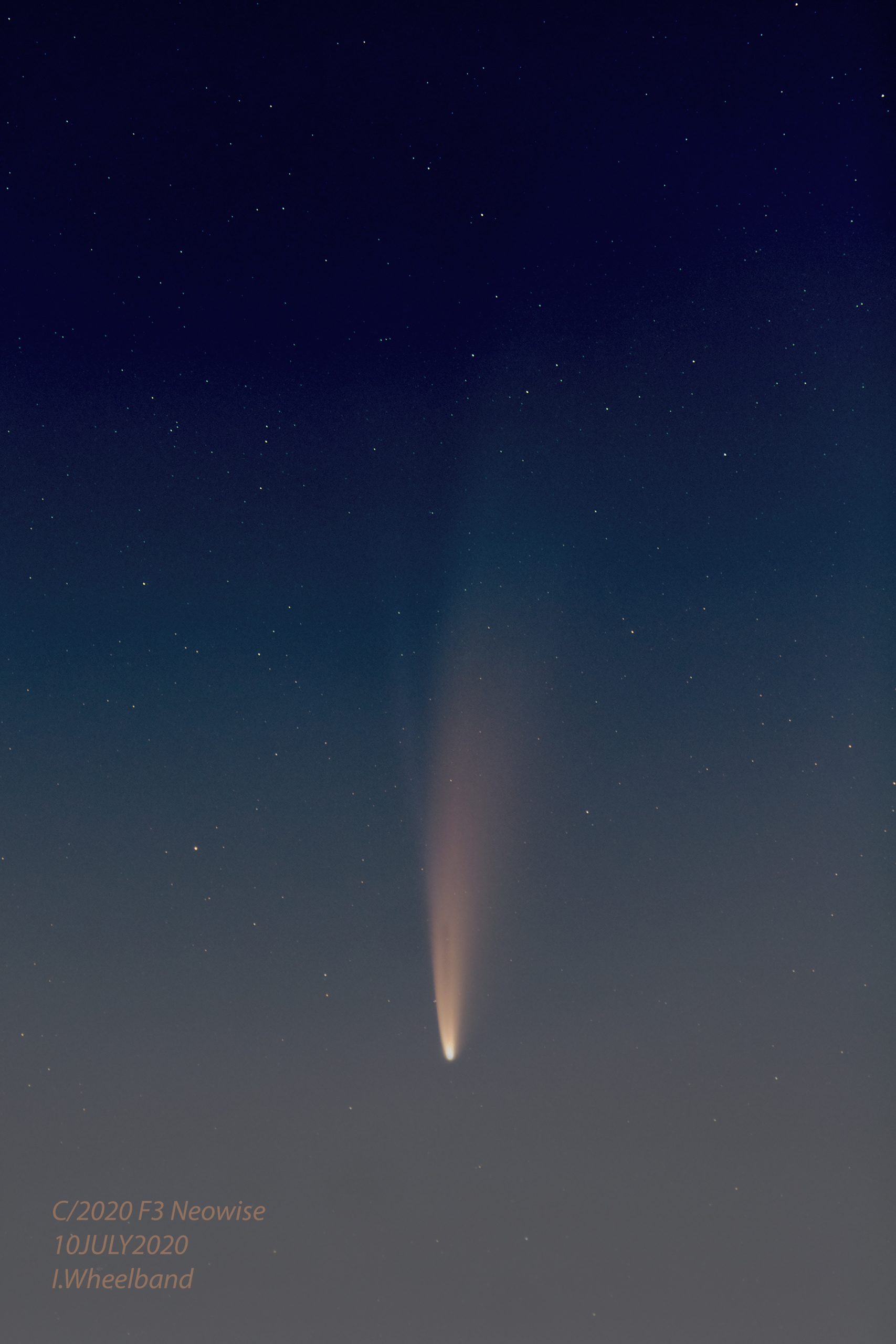
Ian Wheelband captured this close-up view of comet C/2020 F3 (NEOWISE) at 4:17 am on July 11, 2020 from his home in Nova Scotia. Note the brighter tail composed of dropped particles, and the slightly offset ion tail to its left. The stacked, combined 4- and 10-second exposure photograph was taken using his Nikon D7100 and Sigma F2.8 telephoto lens at 200mm, all mounted on a tracking Skywatcher Star Adventurer.
Hello, Comet Lovers!
Here are your Astronomy Skylights for the week of July 5th, 2020 by Chris Vaughan. Feel free to pass this along to your friends and send me your comments, questions, and suggested topics. You can also follow me on Twitter as @astrogeoguy! Unless otherwise noted, all times are expressed in Eastern Time.
I can bring my Digital Starlab portable inflatable planetarium to your school or other daytime or evening event, or teach a session online. Contact me through AstroGeo.ca, and we’ll tour the Universe or the Earth’s interior together!
It’s comet week at last! Bright Comet NEOWISE has become an evening sight across the northern half of the world. Jupiter and nearby Pluto will both reach peak visibility at opposition. The old crescent moon will visit the inner planets before dawn. And you can observe all eight classical planets, plus the dwarf planets Pluto and Ceres, at the same time in the pre-dawn! Here are your Skylights!
Bright Comet NEOWISE Moves into Evening
That long-awaited bright comet, named C/2020 F3 NEOWISE, will become visible after sunset this week! All you will need to see it are clear skies to the northwest, and a very low horizon that is free of obstructing trees and buildings. If you live in an apartment with western or north-facing windows or a balcony, you’re in luck, too.

You can see this comet with your unaided eyes, but it will become truly spectacular through binoculars and telescopes. What you should expect to see is a small, bright, fuzzy spot, possibly with an orange hue. Binoculars will reveal the comet’s faint tail extending generally upwards, away from the sun. Actually, look for two tails pointed in slightly different directions – a brighter one composed of debris the comet is dropping behind it and a fainter, blue-tinted one composed of ionized gas. The latter tail will always point directly away from the sun, since its being pushed by the solar wind. While your telescope will magnify the comet’s head nicely, its tail will extend beyond your limited field of view.
As comets swing through the solar system, we see them move with respect to the background stars – night-to-night, and even hour-by-hour! This comet dropped into the outer solar system from below (or south of) the plane of the planets’ orbits. It passed through that plane as it rounded the sun just, beyond the orbit of Mercury, on July 3. Now it is swinging upwards (north of that plane) while it flies away from the sun. That trajectory will bring the comet closest to the Earth at 9 pm EDT on Wednesday, July 22, when it will be 103.5 million km or 0.692 Astronomical Units (1 AU is the mean Earth-sun separation). Unfortunately, as the comet nears us, it will also be experiencing less heating from the sun, causing it to fade in visual brightness due to less gas production. It’s a trade-off.
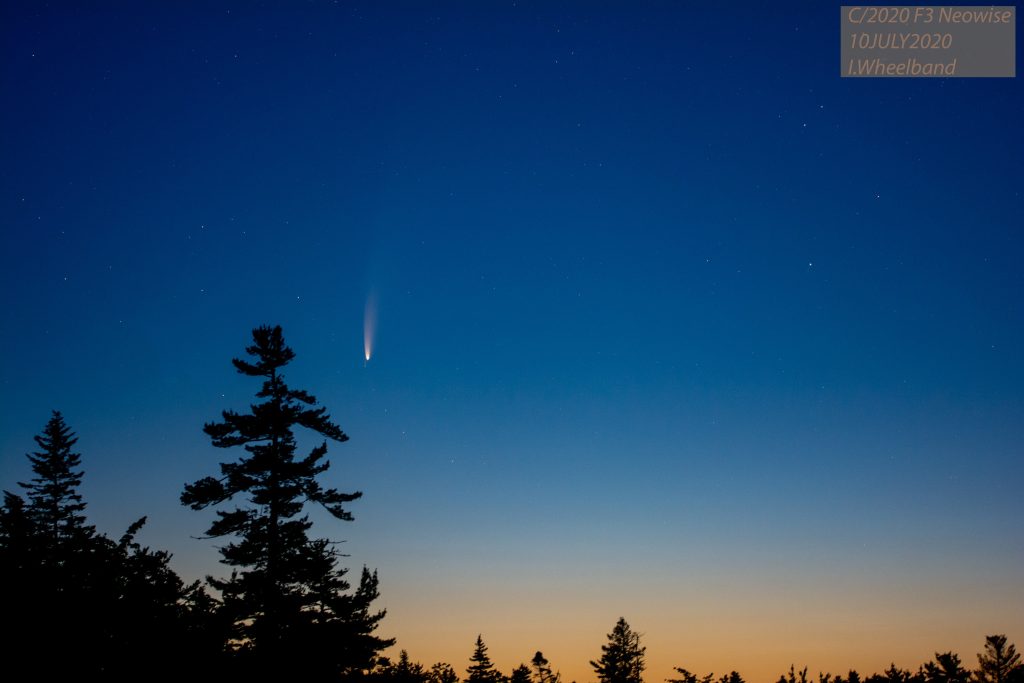
From our point of view on Earth, the comet is heading in a northwesterly direction. The northerly component of that motion will allow the comet to become circumpolar this week. That means it will never set, but it will remain close to the horizon during the night – making it easily visible only during the post-sunset and pre-dawn periods.
As the sky darkens tonight (Sunday), the comet will become observable after about 9:45 pm in your local time zone. At that time it will be less than a fist’s diameter (or 9°) above the northwestern horizon, and descending. By 10:15 pm, the comet will be only a palm’s width above the horizon. After 10:30 pm, it will become too low to see clearly. Once the sun has completely disappeared, you can safely sweep the sky for it with your binoculars.

The best news of all is that the comet will climb nearly a thumb’s width (or 2°) higher every night, making viewing much easier! By next Sunday night, the comet will be shining in a darker sky. Its position will be about 1.5 fist diameters below the stars Dubhe and Merak in the Big Dipper.
For those who want to see the comet before sunrise, it will rise tomorrow (Monday, July 13) at about 2 am local time. (Rise time varies by your latitude). It will be located about two fist diameters to the lower left (or 20° to the celestial east of) the very bright star Capella, over the northwestern horizon. On the coming weekend, the comet will drop lower – moving to the lower right of Merak.

My friend Blake Nancarrow and I recorded a half-hour video about finding, viewing, and photographing the comet. It’s on the RASC Toronto Centre’s YouTube channel here. Let me know if you see it, or get a photo of it!
The Moon
You might have noticed the moon shining in the daytime morning sky this morning. That’s because our natural satellite is traveling sunward on the final week of its monthly trip around Earth. The moon will officially reach its last quarter phase at 7:29 pm EDT, or 23:29 Greenwich Mean Time, today (Sunday, July 12). At last quarter, the moon always rises around midnight and then lingers into the southern sky during the morning daylight hours. The relative positions of the Earth, sun, and moon cause us to see the moon half-illuminated – on its western (left-hand) side – but “last quarter” refers to its progress around Earth, and not its appearance.
Grab your binoculars or telescope and have a look at the moon in daylight – just be careful not to aim your optics anywhere close to the sun. (Parental supervision here is a must!) The region along the curved, pole-to-pole terminator that separates the lit and dark sides on the moon is experiencing sunset. From Earth, that terrain is thrown into stark relief by the slanted sunlight. To increase the moon’s contrast in daytime you can try peering through polarized sunglasses, or left-over 3D glasses from the cinema. Just rotate the lenses until the sky looks darkest.
If you’re up before dawn to see the comet, you can enjoy the waning crescent moon from Monday to Wednesday as it moves through the modest stars of Pisces (the Fishes), Cetus (the Whale), and Aries (the Ram) in the southeastern sky.
On Thursday morning the slimming crescent moon will enter Taurus (the Bull). On Friday it will be positioned less than three finger widths to the upper left (or 2.75° to the celestial northeast) of the bright planet Venus. The moon and the planet will appear together in binoculars until sunrise, and will make a nice photograph when composed with an interesting foreground landscape – and the comet! Under magnification, Venus will show a crescent phase similar to the moon’s.
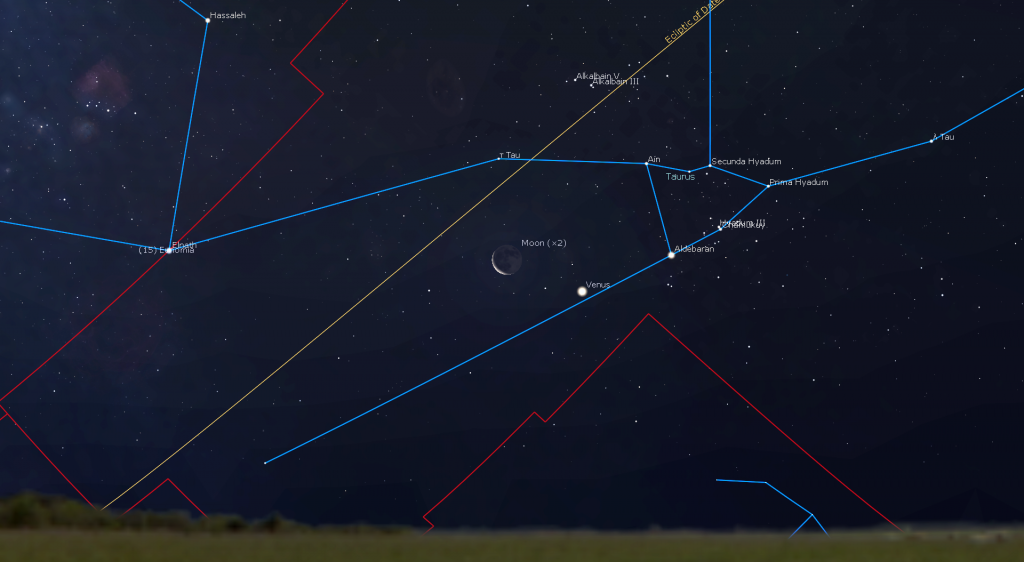
For a short period before dawn on Sunday, July 19, sharp-eyed skywatchers with a clear view over the east-northeastern horizon might spot the very slender crescent of the very old moon sitting four finger widths to the left (or 4.8° to the celestial east) of Mercury. Start your search after about 4:45 am local time, when the pair, which will both appear in the field of binoculars, will sit less than a fist’s diameter above the horizon, among the stars of Gemini (the Twins).
The Planets
If you get outside early to spot the comet, your eye will most definitely be caught by brilliant Venus, which will rise in the east at about 3:15 am local time this week. Last week, Venus’ orbital motion took it directly through the Hyades star cluster. That’s the large, triangular grouping of stars that forms the face of Taurus (the Bull). On Monday morning the bright planet will sit outside the left-hand (eastern) side of the triangle while passing a finger’s width to the left (or 57 arc-minutes to the northeast of) Taurus’ brightest star, Aldebaran. For several mornings, that star and Venus will appear together in the field of view of backyard telescopes at medium magnification, with Venus displaying a crescent phase.
Elusive Mercury will join the pre-dawn sky this week, but it will be a bit tough to spot. Look just above the east-northeastern horizon after it rises, at about 4:45 am local time. The planet will move a little higher every morning, and will end the week with a visit by the crescent moon, as I mentioned above.
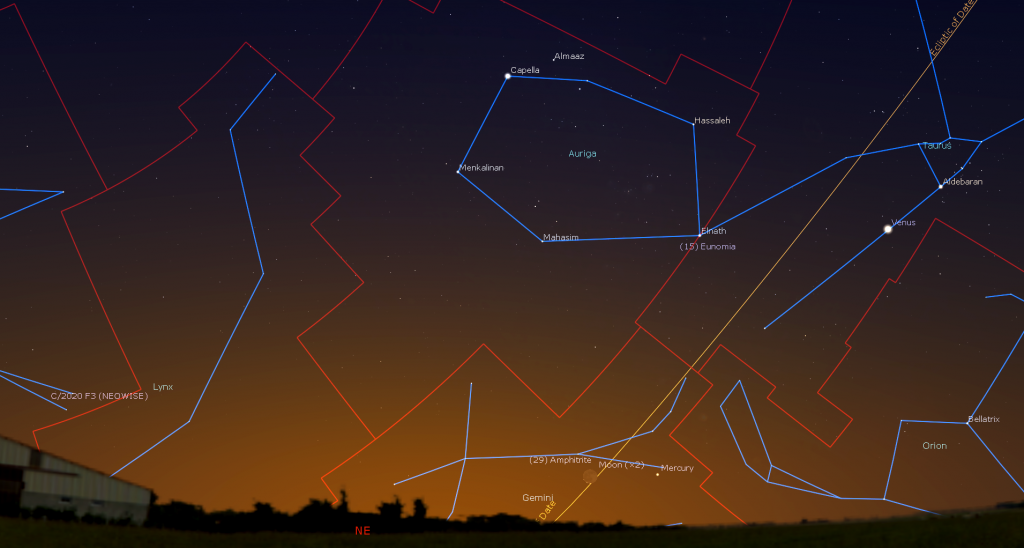
On Tuesday, July 14, the Earth will pass between Jupiter and the sun, placing us closest to the giant planet for 2020. The event, known as opposition, will see Jupiter rise at sunset (at about 8:45 pm local time), and then remain visible all night long. Jupiter will be located 619.2 million km, or 34.4 light-minutes, from Earth, and it will shine at its maximum brightness of magnitude -2.75 for 2020 and show a disk in telescopes that measures 48 arc-seconds across.

On Wednesday, July 15, the dim and distant dwarf planet Pluto will also reach opposition for 2020. On that date, Pluto will be located 4.91 billion km, or 273 light-minutes from Earth, and it will shine with an extremely faint visual magnitude of +14.2. That’s far too dim for visual observing through backyard telescopes; but the planet will actually be located in the sky less than two finger widths to the lower left (or 1.75° to the celestial southeast) of Jupiter. Telescope-owners can also look for a magnitude 8.96 star named HIP96913, which will be sitting directly beside Pluto on July 14, and only 1.3 arc-minutes north of Pluto on opposition night. Even if you can’t see Pluto directly, you will know that it is there.
Good binoculars will reveal Jupiter’s four large Galilean moons named Io, Europa, Ganymede, and Callisto as they dance around the planet from night to night. And a modest-sized telescope will show Jupiter’s brown equatorial belts and the famous Great Red Spot (or GRS, for short). Due to Jupiter’s 10-hour period of rotation, the GRS appears every second or third night from a given location on Earth. In the Eastern Time zone, the Great Red Spot will be crossing the planet’s disk starting after dusk tonight (Sunday), Friday, and next Sunday. It will also appear starting in late evening on Tuesday and Thursday, and before dawn on Tuesday, Thursday, and Sunday.
From time to time, the round, black shadows cast onto Jupiter by its Galilean moons are visible in amateur telescopes as they cross (or transit) the planet’s disk for a few hours. Starting in late evening on Thursday, July 16, observers in the Americas can see Europa’s shadow transiting Jupiter while accompanied by the Great Red spot! The shadow and spot will commence their traverse together at 10:45 pm EDT, or 02:45 GMT. Europa’s shadow will move off of Jupiter at 1:30 am EDT, or 5:30 GMT, leaving the GRS to complete its passage about 90 minutes later.
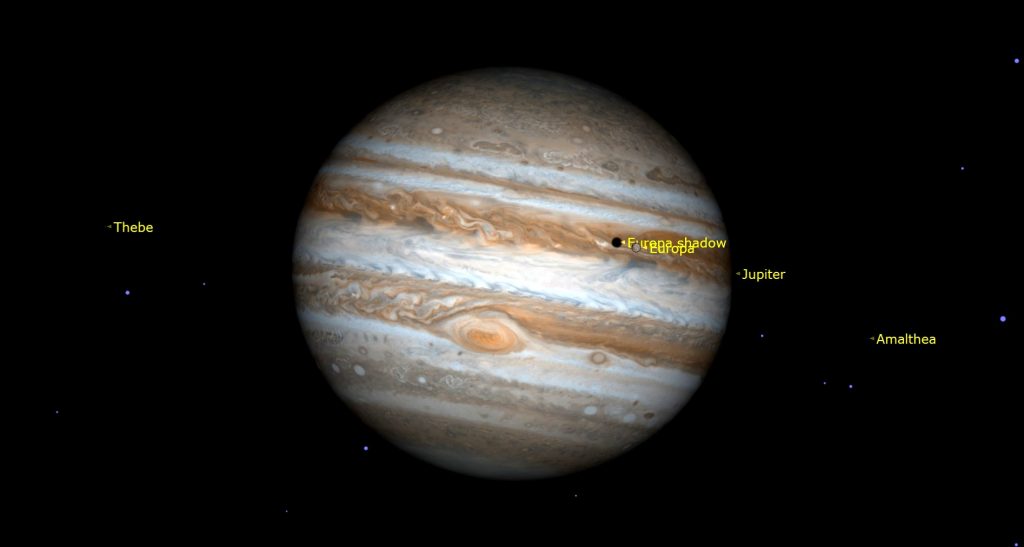
Saturn is the much dimmer, yellowish dot sitting to Jupiter’s lower left all summer. This week it will rise about 25 minutes after Jupiter, and remain observable all night long. (Its own opposition occurs next Monday.) For the rest of this year, those two gas giant planets will dance across the sky together. Look for the stars of Sagittarius (the Archer) and the Milky Way off to their right (west).
In recent weeks, Saturn has been positioned above a globular star cluster named Messier 75 (or NGC 6864). The magnitude 9.2 cluster will appear in binoculars and backyard telescopes as a small, fuzzy patch. This week, the cluster will be located approximately a generous thumb’s width below (or 1.3 degrees to the celestial south of) Saturn. Every morning, the planet’s orbital motion will carry Saturn a little bit to the right (west) compared to the cluster.
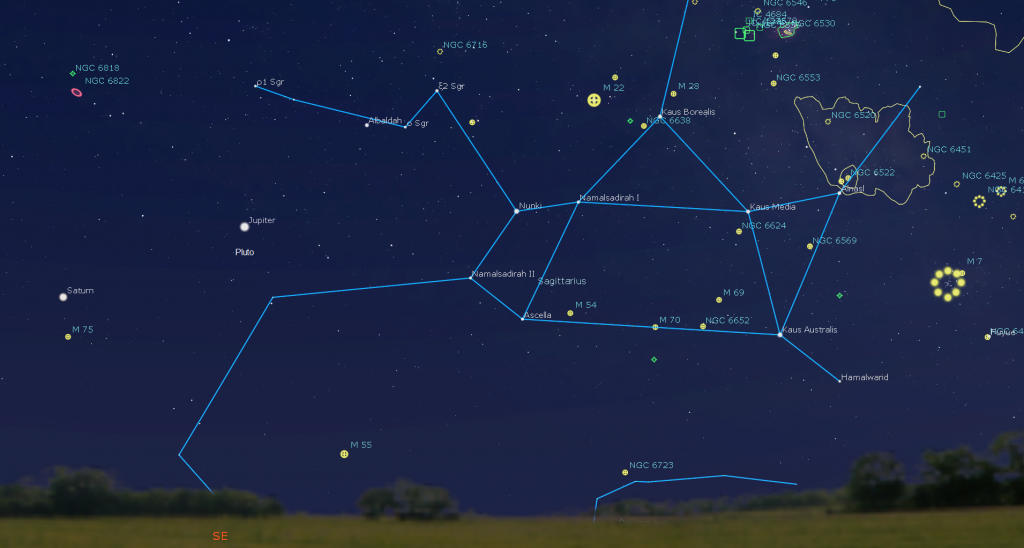
Even a small telescope will show Saturn’s rings and several of its brighter moons – especially its largest moon, Titan! Because Saturn’s axis of rotation is tipped about 27° from vertical (a bit more than Earth’s axis), we can see the top surface of its rings, and its moons can arrange themselves above, below, or to either side of the planet. During this week, Titan will migrate counter-clockwise around Saturn, moving from the upper right of Saturn tonight (Sunday) to the lower left of the planet next Sunday. (Remember that your telescope will flip the view around.)
Mars has been speeding eastward along the ecliptic, causing it to rise several hours after Jupiter and Saturn. This week, Mars will be rising at about midnight local time, and will remain visible as a prominent reddish dot until dawn, when it will be positioned about 3.5 fist diameters above the southeastern horizon. Mars is steadily increasing in disk size and brightness because Earth is travelling towards it this summer. You can’t miss it – nothing else near Mars is anywhere as bright, nor as red.
The dim and distant outer planets Uranus and Neptune are 32° east and 17° west of Mars, respectively. But I’ll hold off describing them until they are visible at a more convenient time.
On Monday, July 13, the main belt asteroid designated (2) Pallas will also reach opposition with a peak visual magnitude of 8.9 – easily within reach of binoculars and backyard telescopes. The asteroid will be situated near the western side of the Summer Triangle asterism, on the border between Vulpecula (the Fox) and Sagitta (the Arrow). It’s also about a fist’s diameter to the right (or 9° to the celestial southwest) of the medium-bright star Albireo in Cygnus (the Swan).
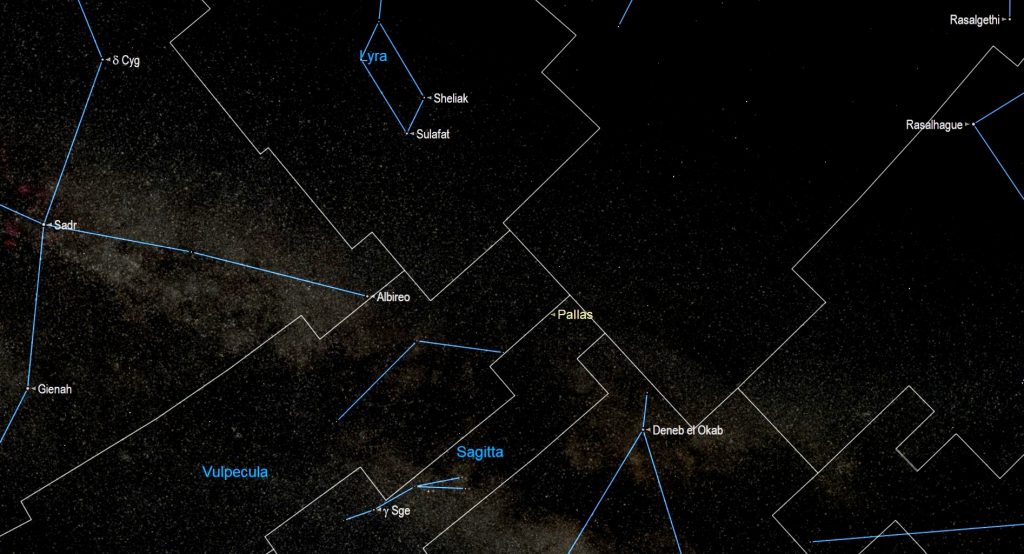
Now that Mercury has appeared, it’s possible to see all eight classical planets (which includes Earth, by looking down) at the same time – plus the dwarf planets Ceres in Aquarius and Pluto below Jupiter, if you have a large enough telescope!
Ogling Ophiuchus
If you missed last week’s tour of Ophiuchus, the 13th zodiac constellation, I posted it here. The dark, moonless evenings this week will be ideal for exploring Ophiuchus.
Public Astro-Themed Events
Every Monday evening, York University’s Allan I. Carswell Observatory runs an online star party – broadcasting views from four telescopes/cameras, answering viewer questions, and taking requests! Details are here. Their in-person Wednesday night viewing has been converted to online via the observatory Youtube channel, where they offer free online viewing through their rooftop telescopes, including their brand new 1-metre telescope! Details are here.
My Insider’s Guide to the Galaxy webcasts with Jenna Hinds of RASC National will continue on Tuesday, July 14 from 3:30 to 5 pm EDT. For this week’s session, we’ll have fun exploring the summer Milky Way, and how you can see its delights yourself, even without a telescope. Details and the schedule are here.
On Wednesday evening, July 15 at 7:30 pm EDT, the RASC Toronto Centre will live stream their monthly Recreational Astronomy Night Meeting at https://www.youtube.com/rasctoronto/live. Talks include the Sky This Month presented by me, backyard astrophotography, a telescope DIY project, and a young scientist experiment: From Outer Space to Sub -surface. Details are here.
The Canadian organization Discover the Universe is offering astronomy broadcasts via their website here, and their YouTube channel here.
On many evenings, the University of Toronto’s Dunlap Institute is delivering live broadcasts. The streams can be watched live, or later on their YouTube channel here.
The Perimeter Institute in Waterloo, Ontario has a library of videos from their past public lectures. Their Lectures on Demand page is here.
Keep looking up, and enjoy the sky when you do. I love questions and requests. Send me some!